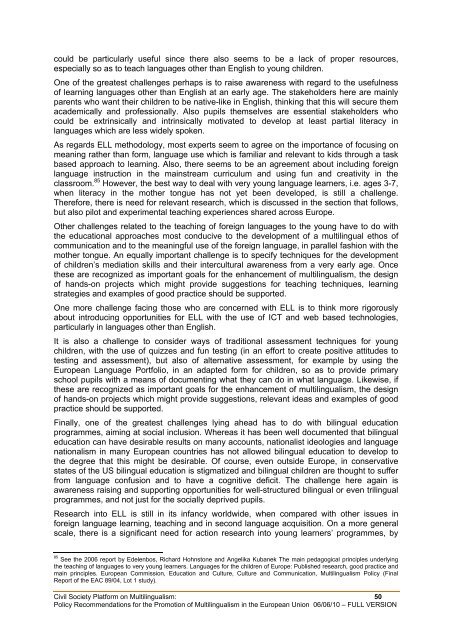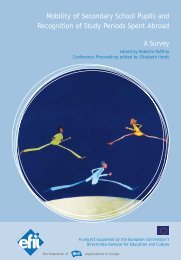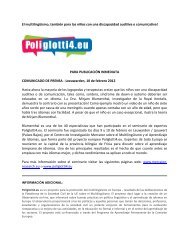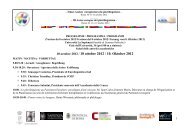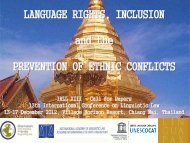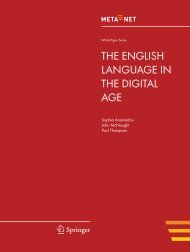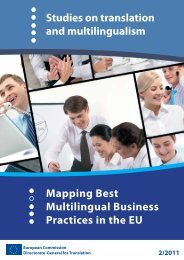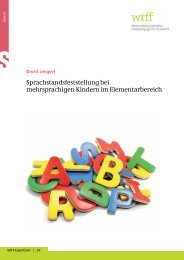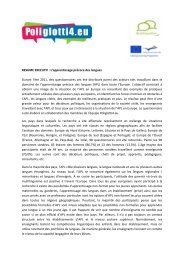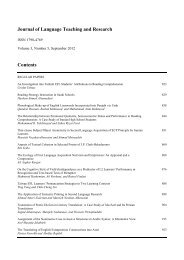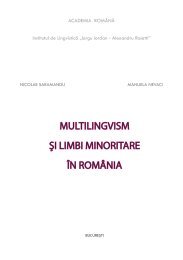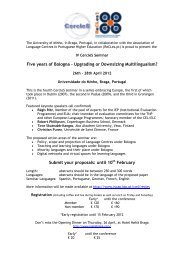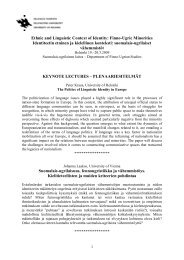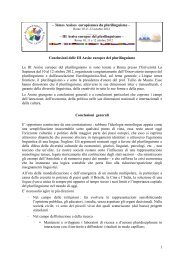FULL VERSION - European Commission - Europa
FULL VERSION - European Commission - Europa
FULL VERSION - European Commission - Europa
Create successful ePaper yourself
Turn your PDF publications into a flip-book with our unique Google optimized e-Paper software.
could be particularly useful since there also seems to be a lack of proper resources,especially so as to teach languages other than English to young children.One of the greatest challenges perhaps is to raise awareness with regard to the usefulnessof learning languages other than English at an early age. The stakeholders here are mainlyparents who want their children to be native-like in English, thinking that this will secure themacademically and professionally. Also pupils themselves are essential stakeholders whocould be extrinsically and intrinsically motivated to develop at least partial literacy inlanguages which are less widely spoken.As regards ELL methodology, most experts seem to agree on the importance of focusing onmeaning rather than form, language use which is familiar and relevant to kids through a taskbased approach to learning. Also, there seems to be an agreement about including foreignlanguage instruction in the mainstream curriculum and using fun and creativity in theclassroom. 85 However, the best way to deal with very young language learners, i.e. ages 3-7,when literacy in the mother tongue has not yet been developed, is still a challenge.Therefore, there is need for relevant research, which is discussed in the section that follows,but also pilot and experimental teaching experiences shared across Europe.Other challenges related to the teaching of foreign languages to the young have to do withthe educational approaches most conducive to the development of a multilingual ethos ofcommunication and to the meaningful use of the foreign language, in parallel fashion with themother tongue. An equally important challenge is to specify techniques for the developmentof children’s mediation skills and their intercultural awareness from a very early age. Oncethese are recognized as important goals for the enhancement of multilingualism, the designof hands-on projects which might provide suggestions for teaching techniques, learningstrategies and examples of good practice should be supported.One more challenge facing those who are concerned with ELL is to think more rigorouslyabout introducing opportunities for ELL with the use of ICT and web based technologies,particularly in languages other than English.It is also a challenge to consider ways of traditional assessment techniques for youngchildren, with the use of quizzes and fun testing (in an effort to create positive attitudes totesting and assessment), but also of alternative assessment, for example by using the<strong>European</strong> Language Portfolio, in an adapted form for children, so as to provide primaryschool pupils with a means of documenting what they can do in what language. Likewise, ifthese are recognized as important goals for the enhancement of multilingualism, the designof hands-on projects which might provide suggestions, relevant ideas and examples of goodpractice should be supported.Finally, one of the greatest challenges lying ahead has to do with bilingual educationprogrammes, aiming at social inclusion. Whereas it has been well documented that bilingualeducation can have desirable results on many accounts, nationalist ideologies and languagenationalism in many <strong>European</strong> countries has not allowed bilingual education to develop tothe degree that this might be desirable. Of course, even outside Europe, in conservativestates of the US bilingual education is stigmatized and bilingual children are thought to sufferfrom language confusion and to have a cognitive deficit. The challenge here again isawareness raising and supporting opportunities for well-structured bilingual or even trilingualprogrammes, and not just for the socially deprived pupils.Research into ELL is still in its infancy worldwide, when compared with other issues inforeign language learning, teaching and in second language acquisition. On a more generalscale, there is a significant need for action research into young learners’ programmes, by85See the 2006 report by Edelenbos, Richard Hohnstone and Angelika Kubanek The main pedagogical principles underlyingthe teaching of languages to very young learners. Languages for the children of Europe: Published research, good practice andmain principles. <strong>European</strong> <strong>Commission</strong>, Education and Culture, Culture and Communication, Multilingualism Policy (FinalReport of the EAC 89/04, Lot 1 study).Civil Society Platform on Multilingualism: 50Policy Recommendations for the Promotion of Multilingualism in the <strong>European</strong> Union 06/06/10 – <strong>FULL</strong> <strong>VERSION</strong>


